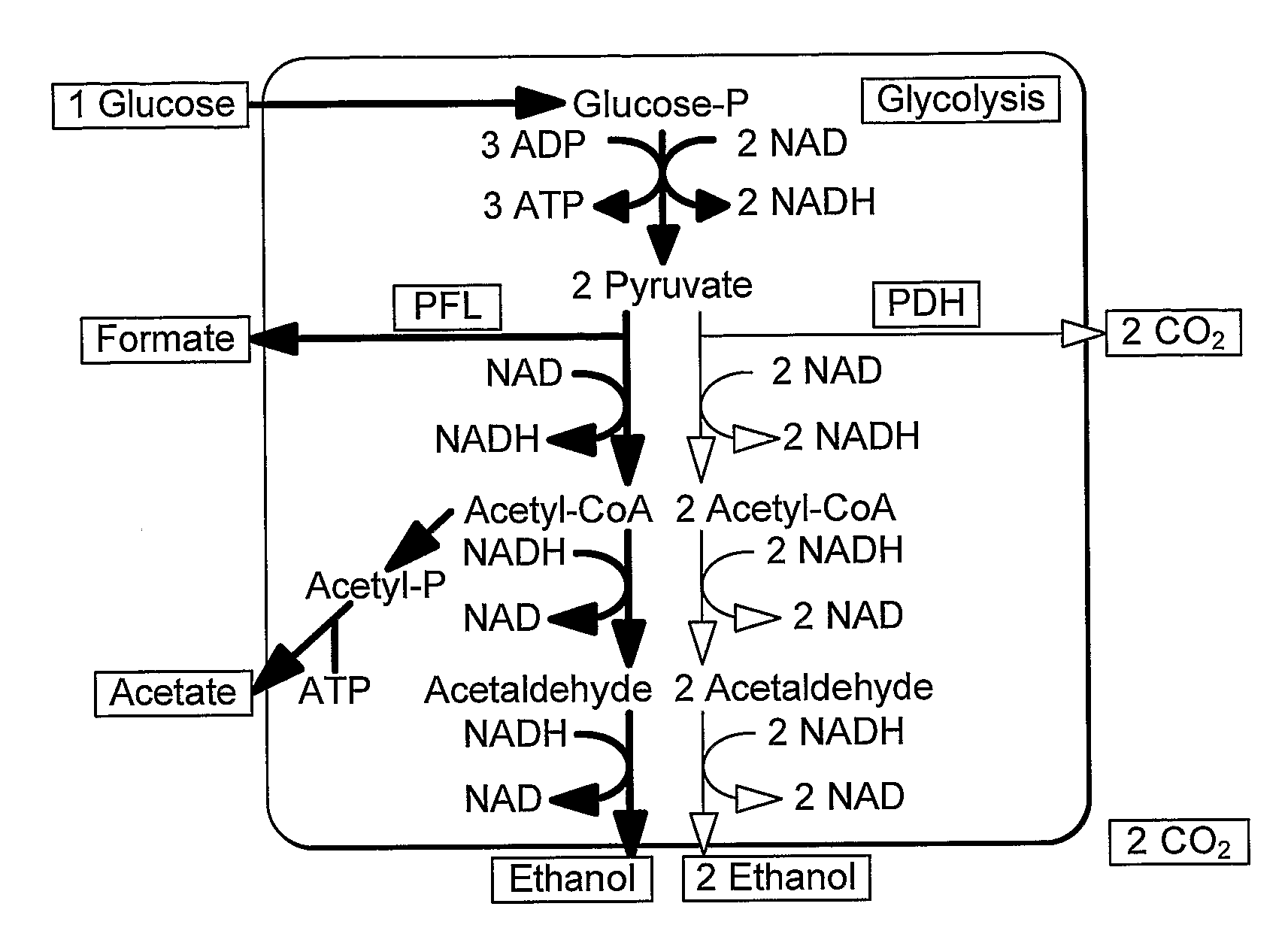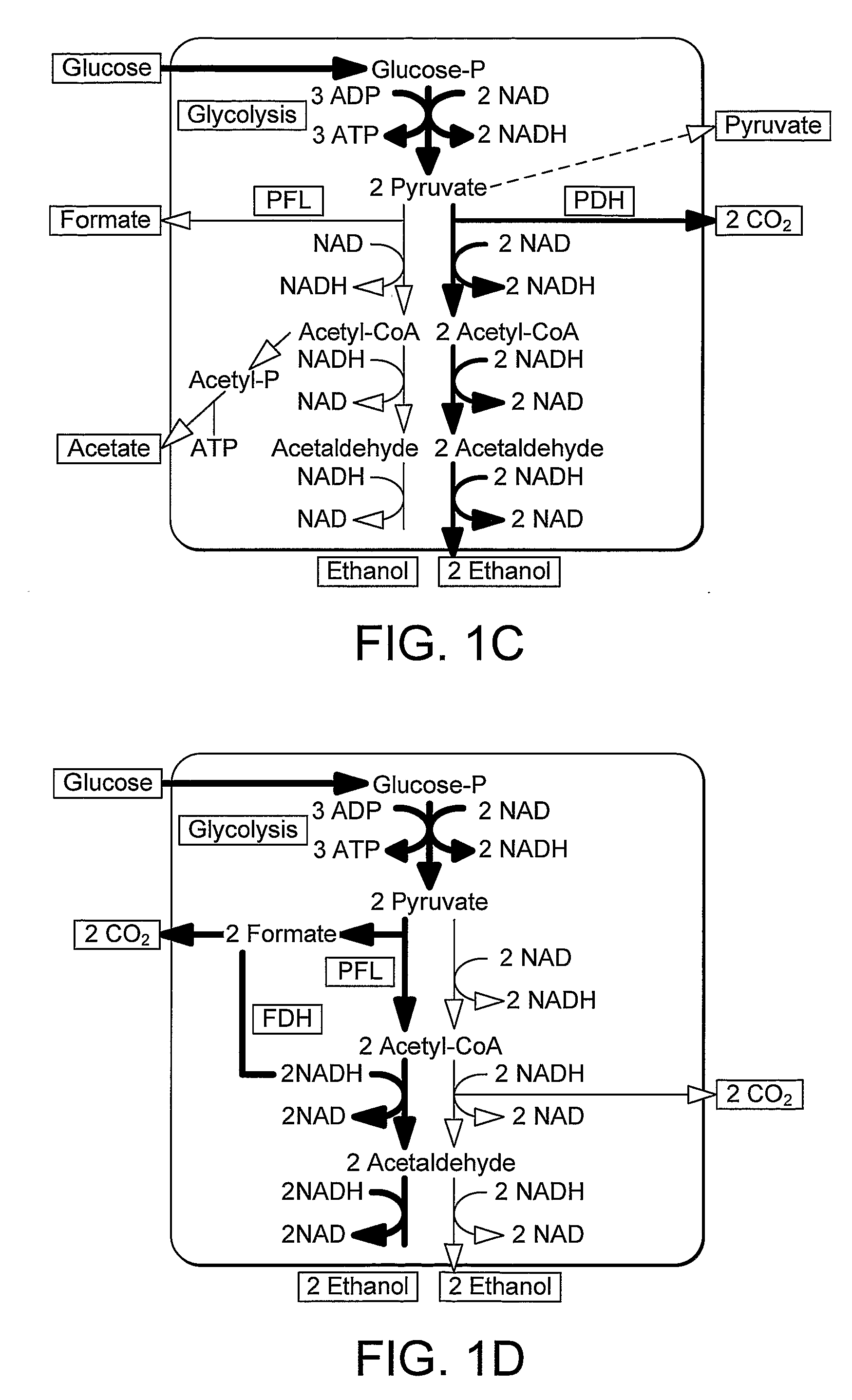Enhancement of Microbial Ethanol Production
a technology of microbial ethanol and ethanol, which is applied in the field of enhancement of microbial ethanol production, can solve the problems of unregulated sugar uptake and glycolysis, difficulty in cellulose fermentation, and high cost, and achieves the effect of high ethanol yield and maximum ethanol yield
- Summary
- Abstract
- Description
- Claims
- Application Information
AI Technical Summary
Benefits of technology
Problems solved by technology
Method used
Image
Examples
example 1
Construction of a Synthetic Formate Dehydrogenase Gene (FIG. 2)
[0067]An amino acid sequence (NCBI Protein Database Accession No P33160—SEQ ID NO:3) of Pseudomonas sp 101 formate dehydrogenases was back translated into DNA sequence with optimised codons for Geobacillus thermoglucosidasius. A promoter and a rho-independent terminator region from a Bacillus strain were added, upstream and downstream of the translated sequence respectively (FIG. 2). The novel sequence showed less than 40% similarity with known fdh gene sequences (37% identity with known fdh1 gene). Xba1 sites were designed into both sides of the construct to facilitate its cloning into suitable vectors.
[0068]The desired sequence was synthesized using the method of Gao et al (see Xinxin Gao, Peggy Yo, Andrew Keith, Timothy J. Ragan and Thomas K. Harris (2003). Nucleic Acids Research, 31 (22), e143) and cloned into pCR-Blunt at its unique Xba1 position. The resulting vector pCR-F1 (FIG. 4) was introduced into E. coli DH5 ...
example 2
Insertion of the fdh Gene into Multiple (IS) Sites
[0070]This strategy applies to strains such as Bacillus stearothermophilus strain LLD-R that contain an Insertion Sequence (IS) that frequently recombines at multiple insertion sites. A vector carrying the fdh gene and this IS sequence is expected to integrate stably at one or more of such locations
Construction of Plasmid pUB-ISF1 (FIG. 5)
[0071]Firstly, the known Insertion Sequence of strain LLD-R (SEQ ID NO: 5 and FIG. 3) is PCR amplified using a forward primer (AGTACTGAAATCCGGATTTGATGGCG—SEQ ID NO:6) and a reverse primer (AGTACTGCTAAATTTCCAAGTAGC—SEQ ID NO:7) with B. stearothermophilus strain LLD-15 as the template. Sca1 restriction sites are introduced in the both ends of the sequence. The PCR product is first cloned in plasmid pCR-TOPO2.1 and the resulting plasmid pCR-IS is then introduced into E. coli DH5 alpha cells and used to isolate the IS region by Sca1 restriction digestion. The isolated IS is then cloned in pUB110 at its ...
example 3
Construction of ldh-Deleted Strains
[0075]The first step is to clone a Bacillus kanomycin resistance marker (kan) and a cassette carrying the ldh gene of B. stearothermophilus strain LLD-R into plasmid pUC18, which can replicate only in gram negative microorganisms.
Construction of a Bacillus Cloning Vector. Plasmid pUCK (FIG. 6).
[0076]A kanamycin resistance gene (kan) was cloned in plasmid pUC18 at its unique Zra1 site which is outside of any coding region and of the reporter gene (lacZ) in the plasmid. To clone the kan gene, a 1.13 kb fragment containing the kanamycin resistance gene was PCR amplified with the primers:
kan-BsZ-F(ACACAGACGTCGGCGATTTGATTCATAC-SEQ ID NO:10)andkan-BsZ-R(CGCCATGACGTCCATGATAATTACTAATACTAGG-SEQ ID NO:11)
using plasmid pUB110 as template. The Zra1 sites were introduced at both ends of the kan gene through the primers. The PCR product was then digested with Zra1 restriction endonuclease enzyme and ligated with previously Zra1-digested and dephosphorylated plas...
PUM
| Property | Measurement | Unit |
|---|---|---|
| temperatures | aaaaa | aaaaa |
| temperature | aaaaa | aaaaa |
| concentration | aaaaa | aaaaa |
Abstract
Description
Claims
Application Information
 Login to View More
Login to View More - R&D
- Intellectual Property
- Life Sciences
- Materials
- Tech Scout
- Unparalleled Data Quality
- Higher Quality Content
- 60% Fewer Hallucinations
Browse by: Latest US Patents, China's latest patents, Technical Efficacy Thesaurus, Application Domain, Technology Topic, Popular Technical Reports.
© 2025 PatSnap. All rights reserved.Legal|Privacy policy|Modern Slavery Act Transparency Statement|Sitemap|About US| Contact US: help@patsnap.com



